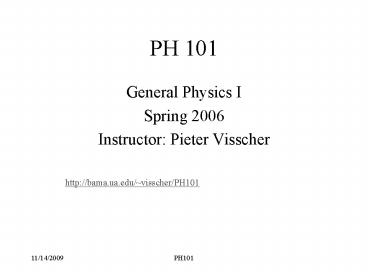PH 101 PowerPoint PPT Presentation
1 / 10
Title: PH 101
1
PH 101
- General Physics I
- Spring 2006
- Instructor Pieter Visscher
http//bama.ua.edu/visscher/PH101
2
What is Physics?
- How things work-- QUANTITATIVELY
- History of physics
- Greeks (3000 yr ago) verbal (philosophy), not
quantitative - Galileo (1500s) measured accelerations of a ball
(quant.) - Newton (1600s) Laws of motion, a F/m,
universal grav. - Physics ?? technology
- Newtons laws (1600s) ? steam engine (1800s)
- Maxwells equations (1861) ? radio (1900), cell
phones - Semiconductor physics (1930s) ? transistor
(1950), computers
3
Measurement and Uncertainty
Measuring means to compare something unknown to a
standard (e.g., yardstick, measuring cup, 100
gram weight, etc.). In physics we try to find
relationships between various quantities. We
express these relationships using algebra.
4
Accuracy with which we can measure a quantity is
called measurement uncertainty or
error. Example With ruler you cant measure
better than about 1 mm. You just cant read
better than one division! Suppose you measure an
object to be 5.2 cm. You state your result as
5.20.1 cm Read section 1.4 to understand how to
deal with the number of significant digits. But
use common sense you dont have to memorize
rules.
5
Units, the SI system
Measurements done relative to standard. A
measured quantity with out units is (in most
cases) meaningless! We use SI (Système
International) units (alias metric or
MKS) Length m Length traveled by light in
vacuum in 1/299,792,458 of a
second. Mass kg A Pt-Ir cylinder defined as
1 kg. Time s Time required for
9,192,631,770 periods of a
specific emission line of a Cesium gas laser
Legal definition of 1 inch 2.54 cm!
6
Metric and English Units
Metric English meter
length foot kilogram mass
slug second time second
Special names are given to round-number multiples
of metric units to avoid dealing with very small
or very large numbers. There is a mnemonic
(courtesy of C. Alexander) for these
Many Kids Have Dropped Over Dead Changing Metric
Units
Mega Kilo Hecto Deca 0 Deci Centi
Milli Micro(m) 106 103 102 101
100 10-1 10-2 10-3 10-6
7
Unit Conversions
- 1 inch 2.54 cm, 1 foot 12 in, 1 meter
100 cm - g acceleration of gravity 9.8 m/s2 , change
to English units via multiply-by-one method - 1 atm 1.015 N/m2, change to lb/in2
8
Math Review(See Appendix A of textbook)
Algebra (solving for unknowns)
v0, v025 m/s, x 50 m Solve for a.
a -6.25 m/s2
Quadratic Equation ax2bxc 0 x -b /-
(b2-4ac)1/2/2a (example) -105m (5.5m/s) t 1/2
(-9.8m/s2) t2
Soln t 5.2 sec
9
Math Review
Trigonometry
c
a
sinQ a/c, cosQ b/c tanQ a/b
Q
b
c2 a2 b2
(Pythagorean Theorem)
V
vy
Example
Q
V 785 km/h, find Vx and Vy
Vx
Vx VsinQ 489 km/h Vy VcosQ 614
km/h CHECK 7852 4892 6142
10
Problem Solving
- Read and reread the problem carefully.
- Draw a diagram, using a coordinate system, and
choose - directions (X and Y) to be positive and
negative. - You must be consistent in applying these
- directions.
- 3. Write down the quantities that are given and
then the quantities - you are trying to find.
- 4. Decide which principles of physics will apply
to this problem. - 5. Consider the equations that relate to the
known and unknown - quantities. Solve the equations for the unknown
quantities. - 6. Carry out the numerical calculation.
- 7. Is the answer reasonable?
- 8. Keep track of units and be sure they are
consistent.

